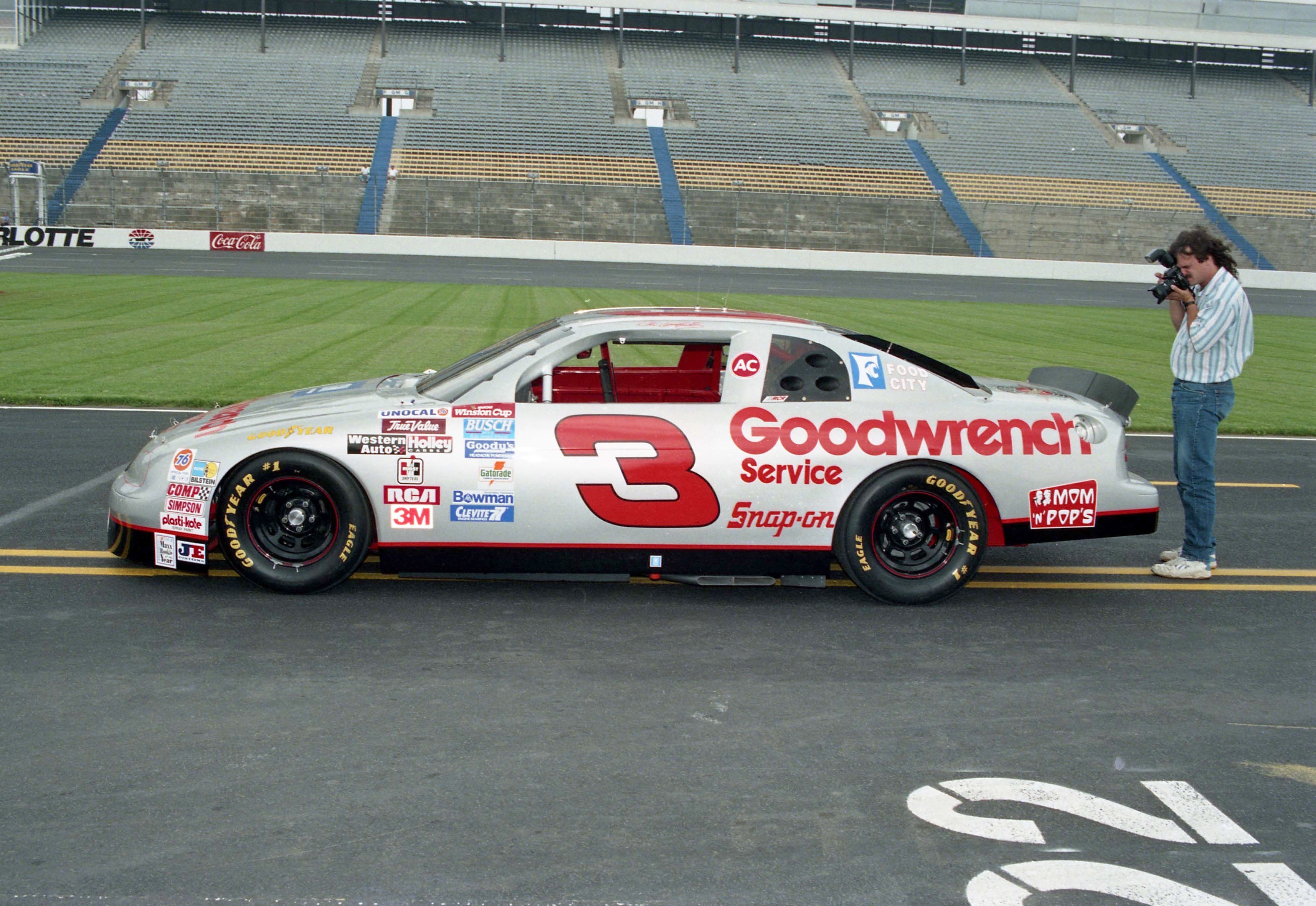The Black Widow Rocked NASCAR
by Tom Jensen July 05, 2021
A secret back-door plan allowed Chevrolet to build a car that won a NASCAR championship in 1957.
“Dale Jr.: Glory Road Champions” is a featured exhibit in the NASCAR Hall of Fame, with 18 cars representing 15 drivers who won a total of 46 premier series championships. Every driver who has a car on Glory Road won at least one championship, and 10 of the 15 claimed more than one.
Represented in the exhibit are cars from seven decades of NASCAR racing and seven different manufacturers.
One of the most distinctive cars on Glory Road is a replica of the 1957 Chevrolet that Hall of Famer Buck Baker (2013) drove to his second consecutive premier series championship. Known as “The Black Widow,” the striking Chevrolet 150 two-door sedan has quite a history.

Buck Baker and Jack Smith put their Black Widow Chevrolets out front at Wilson (N.C.) Speedway in March 1957. Photo courtesy of NASCAR Archives & Research Center via Getty Images
The story behind the Black Widow is an interesting insight into how NASCAR and the automobile manufacturers functioned back in the day.
On June 6, 1957, the Automobile Manufacturers Association, a coalition of U.S. automakers, formally banned automobile racing. The group prohibited the advertising of race results, promoting the speed features of race cars, providing pace cars to tracks and other marketing activities.
This came in response to heavy Congressional pressure in the wake of a crash at the 24 Hours of Le Mans in 1955 that killed more than 80 people when a car went off course and crashed into the stands, exploding in a ball of fire.

In 1957, Buck Baker won 10 races and his second consecutive premier series championship with a Chevrolet he owned that was nicknamed, “The Black Widow.” Photo courtesy of Tom Jensen
Rather than have Congress legislatively mandate a withdrawal from racing, the automakers did it themselves. At least that was the public perception.
And at the same time, they were doing everything they could behind the scenes to get around their own restrictions. In the case of General Motors, they hired former Hudson lead race engineer Vince Piggins and moved him to Atlanta, where he established a business known as the Southern Engineering and Development Co., or SEDCO, which was run out of Nalley Chevrolet, an Atlanta dealership that eventually expanded into more than dozen retail outlets in the region.

The Black Widow 1957 Chevrolet is prominently displayed on Glory Road. Photo courtesy of Jamey Price
Under Piggins’ watchful eye, SEDCO built the first Black Widow race car, choosing its nickname for the distinctive black and white paint scheme.
The car was based on the economy Chevy One-Fifty Utility Sedan — or 150, for short — the cheapest and lightest full-sized car in the 1957 Chevrolet lineup. It featured a host of special go-fast items: a fuel-injected, 283-cubic-inch, 283-horsepower small-block Chevy engine, three-speed manual transmission, six-lug wheels, 20-gallon gas tank and no radio, cigarette lighter or arm rests.
In April 1957, Piggins put together a manual called the “1957 Chevrolet Stock Car Competition Guide,” which explained in great detail how Chevrolet dealers could build their own Black Widows. The manual, which was mailed to 411 Chevrolet dealerships across the country, contained 170 individual GM-made parts that were needed to convert a stock Chevy 150 street car to a full-on NASCAR race car.

The distinctive black-and-white paint scheme gave The Black Widow its nickname. Photo courtesy of Jamey Price
“This valuable brochure is provided to acquaint dealers, as well as performance-minded individuals, with the techniques that permit greatly safety and entertainment value for all who enjoy stock-car competition in the highest traditions of the sport,” GM wrote in the introduction of the manual.
The guide had some interesting details. On color choice, it noted “green is taboo in most American racing circles,” an old superstition about the sport.
And it recommended the 150 as the model to race because, “It is rugged and dependable, low in cost, with no unnecessary weight to hamper performance; and conforms with all (NASCAR) sanction requirements.”

Jack Smith (car No. 47) won four races in his Chevrolet during the 1957 season. Photo courtesy of NASCAR Archives & Research Center/CQ-Roll Call Group via Getty Images
GM ordered SEDCO to be shut down after the racing ban, but in private hands and with — allegedly — no factory support, the Black Widows were raced successfully all season long in 1957. The three most prominent Black Widow drivers were Baker in the No. 87, Jack Smith in the No. 47 and Speedy Thompson in the No. 46.
Baker would go on to win the 1957 NASCAR premier series championship in a Black Widow, with Thompson finishing third in points and Smith fifth. Collectively, the trio amassed 16 race victories and 63 top-five finishes during the 1957 season.
This despite the fact that rules were changed in mid-season to outlaw fuel injection. Others who drove them included: Rex White, Bob Welborn and Fireball Roberts.
To this day, the Black Widow remains a subject of much discussion among Chevrolet fans.
— Tom Jensen
To this day, the Black Widow remains a subject of much discussion among Chevrolet fans, and intense debate as well.
No one knows exactly how many Black Widows were built or how many survived, and the details of the car are a source of endless discussion and fascination among the hard-core NASCAR fans.
But this much is certain: For one season in 1957, the Black Widows ruled NASCAR and were lethal to the competition.
Plan your visit to the NASCAR Hall of Fame and purchase tickets by visiting nascarhall.com/tickets.













